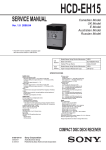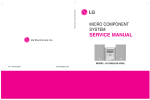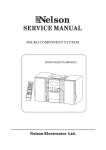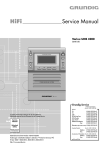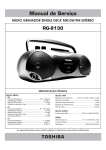Download Zenith LX-140 CD Shelf System - Zenith%20LX140%20Service%20Manual
Transcript
MICRO COMPONENT [CONTENTS] ❍ SECTION 1. GENERAL • SERVICING PRECAUTIONS . . . . . . . . . . . . . . . . . . . . . . . . . . . . . . . . . . . . . . . . . . . . . . . 1-2 • ESD PRECAUTIONS . . . . . . . . . . . . . . . . . . . . . . . . . . . . . . . . . . . . . . . . . . . . . . . . . . . . . 1-4 • SPECIFICATION . . . . . . . . . . . . . . . . . . . . . . . . . . . . . . . . . . . . . . . . . . . . . . . . . . . . . . . . . .1-5 ❍ SECTION 2. ELECTRICAL • ADJUSTMENTS . . . . . . . . . . . . . . . . . . . . . . . . . . . . . . . . . . . . . . . . . . . . . . . . . . . . . . . . . 2-1 • TROUBLESHOOTING . . . . . . . . . . . . . . . . . . . . . . . . . . . . . . . . . . . . . . . . . . . . . . . . . . . . 2-2 • WAVEFORMS OF MAJOR CHECK POINT . . . . . . . . . . . . . . . . . . . . . . . . . . . . . . . . . . . . 2-11 • BLOCK DIAGRAM . . . . . . . . . . . . . . . . . . . . . . . . . . . . . . . . . . . . . . . . . . . . . . . . . . . . . . . 2-21 • SCHEMATIC DIAGRAMS . . . . . . . . . . . . . . . . . . . . . . . . . . . . . . . . . . . . . . . . . . . . . . . . . 2-23 • WIREING DIAGRAM . . . . . . . . . . . . . . . . . . . . . . . . . . . . . . . . . . . . . . . . . . . . . . . . . . . . . 2-31 • PRINTED CIRCUIT DIAGRAMS . . . . . . . . . . . . . . . . . . . . . . . . . . . . . . . . . . . . . . . . . . . . 2-32 • INTERNAL BLOCK DIAGRAM OF ICs . . . . . . . . . . . . . . . . . . . . . . . . . . . . . . . . . . . . . . . 2-39 ❍ SECTION 3. EXPLODED VIEWS • CABINET AND MAIN FRAME SECTION . . . . . . . . . . . . . . . . . . . . . . . . . . . . . . . . . . . . . . . .3-1 ❍ SECTION 4. SPEAKER • SPEAKER PART . . . . . . . . . . . . . . . . . . . . . . . . . . . . . . . . . . . . . . . . . . . . . . . . . . . . . . . . . .4-1 ❍ SECTION 5. REPLACEMENT PARTS LIST • REPLACEMENT PARTS LIST . . . . . . . . . . . . . . . . . . . . . . . . . . . . . . . . . . . . . . . . . . . . . . . .5-1 - 1-1 - SECTION 1. GENERAL ❏ SERVICING PRECAUTIONS NOTES REGARDING HANDLING OF THE PICK-UP 1. Notes for transport and storage 1) The pick-up should always be left in its conductive bag until immediately prior to use. 2) The pick-up should never be subjected to external pressure or impact. Storage in conductive bag Drop impact 2. Repair notes 1) The pick-up incorporates a strong magnet, and so should never be brought close to magnetic materials. 2) The pick-up should always be handled correctly and carefully, taking care to avoid external pressure and impact. If it is subjected to strong pressure or impact, the result may be an operational malfunction and/or damage to the printed-circuit board. 3) Each and every pick-up is already individually adjusted to a high degree of precision, and for that reason the adjustment point and installation screws should absolutely never be touched. 4) Laser beams may damage the eyes! Absolutely never permit laser beams to enter the eyes! Also NEVER switch ON the power to the laser output part (lens, etc.) of the pick-up if it is damaged. NEVER look directly at the laser beam, and don’t let contact fingers or other exposed skin. 5) Cleaning the lens surface If there is dust on the lens surface, the dust should be cleaned away by using an air bush (such as used for camera lens). The lens is held by a delicate spring. When cleaning the lens surface, therefore, a cotton swab should be used, taking care not to distort this. Pressure Magnet Pressure How to hold the pick-up Cotton swab Conductive Sheet 6) Never attempt to disassemble the pick-up. Spring by excess pressure. If the lens is extremely dirty, apply isopropyl alcohol to the cotton swab. (Do not use any other liquid cleaners, because they will damage the lens.) Take care not to use too much of this alcohol on the swab, and do not allow the alcohol to get inside the pick-up. - 1-2 - NOTES REGARDING COMPACT DISC PLAYER REPAIRS 1. Preparations 1) Compact disc players incorporate a great many ICs as well as the pick-up (laser diode). These components are sensitive to, and easily affected by, static electricity. If such static electricity is high voltage, components can be damaged, and for that reason components should be handled with care. 2) The pick-up is composed of many optical components and other high-precision components. Care must be taken, therefore, to avoid repair or storage where the temperature of humidity is high, where strong magnetism is present, or where there is excessive dust. 2. Notes for repair 1) Before replacing a component part, first disconnect the power supply lead wire from the unit 2) All equipment, measuring instruments and tools must be grounded. 3) The workbench should be covered with a conductive sheet and grounded. When removing the laser pick-up from its conductive bag, do not place the pick-up on the bag. (This is because there is the possibility of damage by static electricity.) 4) To prevent AC leakage, the metal part of the soldering iron should be grounded. 5) Workers should be grounded by an armband (1M Ω) 6) Care should be taken not to permit the laser pick-up to come in contact with clothing, in order to prevent static electricity changes in the clothing to escape from the armband. 7) The laser beam from the pick-up should NEVER be directly facing the eyes or bare skin. Armband Resistor (1 Mohm) Resistor (1 Mohm) Conductive Sheet CLEARING MALFUNCTION You can reset your unit to initial status if malfunction occur(button malfunction, display, etc.). Using a pointed good conductor(such as driver), simply short the RESET jump wire on the inside of the volume knob for more than 3 seconds. If you reset your unit, you must reenter all its settings(stations, clock, timer) NOTE: 1. To operate the RESET jump wire, pull the volume rotary knob and release it. 2. If you wish to operate the RESET jump wire, it is necessary to unplug the power cord. VOLUME UP RESET jump wire VOLUME KNOB DOWN - 1-3 - ❏ ESD PRECAUTIONS Electrostatically Sensitive Devices (ESD) Some semiconductor (solid state) devices can be damaged easily by static electricity. Such components commonly are called Electrostatically Sensitive Devices (ESD). Examples of typical ESD devices are integrated circuits and some field-effect transistors and semiconductor chip components. The following techniques should be used to help reduce the incidence of component damage caused by static electricity. 1. Immediately before handling any semiconductor component or semiconductor-equipped assembly, drain off any electrostatic charge on your body by touching a known earth ground. Alternatively, obtain and wear a commercially available discharging wrist strap device, which should be removed for potential shock reasons prior to applying power to the unit under test. 2. After removing an electrical assembly equipped with ESD devices, place the assembly on a conductive surface such as aluminum foil, to prevent electrostatic charge buildup or exposure of the assembly. 3. Use only a grounded-tip soldering iron to solder or unsolder ESD devices. 4. Use only an anti-static solder removal device. Some solder removal devices not classified as "anti-static" can generate electrical charges sufficient to damage ESD devices. 5. Do not use freon-propelled chemicals. These can generate electrical charges sufficient to damage ESD devices. 6. Do not remove a replacement ESD device from its protective package until immediately before you are ready to install it. (Most replacement ESD devices are packaged with leads electrically shorted together by conductive foam, aluminum foil or comparable conductive materials). 7. Immediately before removing the protective material from the leads of a replacement ESD device, touch the protective material to the chassis or circuit assembly into which the device will by installed. CAUTION : BE SURE NO POWER IS APPLIED TO THE CHASSIS OR CIRCUIT, AND OBSERVE ALL OTHER SAFETY PRECAUTIONS. 8. Minimize bodily motions when handing unpackaged replacement ESD devices. (Otherwise harmless motion such as the brushing together of your clothes fabric or the lifting of your foot from a carpeted floor can generate static electricity sufficient to damage an ESD device). CAUTION. GRAPHIC SYMBOLS THE LIGHTNING FLASH WITH APROWHEAD SYMBOL. WITHIN AN EQUILATERAL TRIANGLE, IS INTENDED TO ALERT THE SERVICE PERSONNEL TO THE PRESENCE OF UNINSULATED “DANGEROUS VOLTAGE” THAT MAY BE OF SUFFICIENT MAGNITUDE TO CONSTITUTE A RISK OF ELECTRIC SHOCK. THE EXCLAMATION POINT WITHIN AN EQUILATERAL TRIANGLE IS INTENDED TO ALERT THE SERVICE PERSONNEL TO THE PRESENCE OF IMPORTANT SAFETY INFORMATION IN SERVICE LITERATURE. - 1-4 - ❏ SPECIFICATIONS - 1-5 - MEMO - 1-6 - SECTION 2. ELECTRICAL ❏ ADJUSTMENTS This set has been aligned at the factory and normally will not require further adjustment. As a result, it is not recommended that any attempt is made to modificate any circuit. If any parts are replaced or if anyone tampers with the adjustment, realignment may be necessary. IMPORTANT 1. Check Power-source voltage. 2. Set the function switch to band being aligned. 3. Turn volume control to minimum unless otherwise noted. 4. Connect low side of signal source and output indicator to chassis ground unless otherwise specified. 5. Keep the signal input as low as possible to avoid AGC and AC action. TAPE DECK ADJUSTMENT 1. AZIMUTH ADJUSTMENT Deck Mode Palyback Test Tape MTT-114 Test Point Speaker Out Adjustment DECK Screw Azimuth Screw Electronic Voltmeter Head Playback Mode Dual-trace synchroscope Speaker Out L out L ch Test Tape MTT-114 Adjust for Maximum CH1 CH2 Unit R ch GND R out Figure 1. Azimuth Adjustment Connection Diagram 2. TUNER ADJUSTMENT Item DC Voltage Test Point Check point TP1, TP2 Adjustment DECK Screw Speaker Out Head Playback Mode Frequency Counter L out Test Tape MTT-111 Unit Record/Playback head R out GND Figure 1. Azimuth Adjustment Connection Diagram - 2-1 - Adjust for 0V ± 50mV ❏ TROUBLESHOOTING • CD PART - 2-2 - • OPEN CLOSE NG - 2-3 - • “ READING ” DISPLAY CHECK (= ONLY “CD “DISPLAY) - 2-4 - • READING OK CHECK (= “NO DISC” DISPLAY) - 2-5 - • READING OK CHECK #A (= “NO DISC” DISPLAY) - 2-6 - • READING OK CHECK #B (= “NO DISC” DISPLAY) - 2-7 - • READING OK CHECK #C (= “NO DISC” DISPLAY) - 2-8 - • READING OK CHECK #D (= “NO DISC” DISPLAY) - 2-9 - • READING OK CHECK # E (= “NO DISC” DISPLAY) - 2-10 - ❏ WAVEFORMS OF MAKOR CHECK POINT - 2-11 - #4. SPINDLE DRIVE AND MOTOR WAVEFORM (IC503 pin6, 1 2) when TOC reading #5. TRACK DRIVE AND MOTOR WAVEFORM (TP560, IC503 pin23) during normal play #6. RF, TRACKING AND FOCUS ERROR WAVEFORM (IC502 pin8, 2 1 , 23) during normal play - 2-12 - ❏ AUDIO PART - 2-13 - - 2-14 - - 2-15 - - 2-16 - FM(TU101) Troubleshooting Check the 12V input of TU101 pin6 NO YES Check the “High” of TU101 Pin5 Check the 12V of Q102 “E” YES Check the “LOW” of IC103 pin7 YES Replace the Q102 Check the Power circuit Refer to “IC103 Troubleshooting” NO YES Check the OSC waveform of TU101 pin8 NO YES Replace the TU101 Refer to “IC102 Troubleshooting” IC102 Troubleshooting Check the power input of IC102 pin8 NO Refer to “Power Troubleshooting” YES Check the wavefor of IC102 Pin20, 21 NO YES Check the FM(TU101), AM(L102) Replace the IC102 Check the waveform output IC102 pin 16, 17 NO YES Check the “LOW” of IC102 Pin 13 END Replace the IC103 - 2-17 - Refer to “IC103 Troubleshooting” IC103 Troubleshooting Check the Power input of IC103 pin17 NO Refer to “Power Troubleshooting” YES X104 oscillation NO YES Check the Clock of CE, DI, DO, CLK NO YES Repleace the X104 Refer to “IC103 Troubleshooting” CE: Chip Enable DI: Data Input (from u-com) DO: Data Output (to u-com) CLK: Tuner mode clock Check the operation NO YES Repleace the IC103 END AM COIL Troubleshooting Check the “High” of L102 Pin2 NO Refer to “IC103 Troubleshooting” YES Check the oscillation the L102 pin 13 Replace the L102 Check the IC102 Troubleshooting - 2-18 - PLAY Check the B+ Power to LEAF Switch NO YES Check the signal to IC202 pin4, 11 YES NO Check the output to speaker Check the SW201 and HEAD connector YES Check the CN202 Checks the B+ power to Q201 “E” YES NO Check the CN201 Check the CN901 pin8, 9 and IC903 output REC Check the signal input of IC201 pin4, 11 NO YES Check the oscillation of L201 YES Check the signal input to PN201 pin8, 9 Check the of CN201 pin4, 5 YES Check the HEAD connector - 2-19 - NO Check the B+ of LEAF switch NO Check the R218, L201, L204 MEMO - 2-20 - ❏ BLOCK DIAGRAM 2-21 2-22 ❏ SCHEMATIC DIAGRAMS • FRONT/POWER SCHEMATIC DIAGRAM 2-23 2-24 • MAIN/DECK SCHEMATIC DIAGRAM 2-25 2-26 • TUNER SCHEMATIC DIAGRAM 2-27 2-28 • CDP SCHEMATIC DIAGRAM 2-29 2-30 ❏ WIRING DIAGRAM 2-31 2-32 ❏ PRINTED CIRCUIT DIAGRAMS • FRONT P.C. BOARD 2-33 2-34 • MAIN P.C. BOARD 2-35 2-36 • CDP P.C. BOARD 2-37 2-38 ❏ INTERNAL BLOCK DIAGRAM OF ICs ■ IC300 LC87F73C8A 1) Pin Assignment - 2-39 - ■ IC601 TDA7468D 1) BLOCK DIAGRAM - 2-40 - 2) PIN CONNECTION - 2-41 - ■ IC301 BU1923 1) BLOCK DIAGRAM - 2-42 - ■ IC102LA1837 1) BLOCK DIAGRAM ■ IC102LA1837 2) Test Circuit Diagram - 2-43 - ■ IC103 LC72131D 1) Pin Assignments - 2-44 - ■ IC201 AN7312 1) BLOCK DIAGRAM ■ IC701 LA4631 1) BLOCK DIAGRAM - 2-45 - ■ IC504 M12L16161A 1) Synchronous DRAM • PIN Definitions PIN CLK CS NAME System Clock Chip Select CKE Clock Enable A0~A10/AP Address BA Bank Select Address RAS Row Address Strobe CAS Column Address Strobe WE Write Enable L(U)DQM Data Input/Output Mask INPUT FUNCTION Active on the positive going edge to sample all inputs. Disables or enables device operation by masking or enabling all inputs except CLK, CKE and L(U)DQM. Masks system clock to freeze operation from the next clock cycle. CKE should be enabled at least one cycle prior to new command. Disable input buffers for power down in standby. Row/column addresses are multiplexed on the same pins. Row address: RA0 ~ RA10, column address : CA0~CA7 Selects bank to be activated during row address latch time. Selects bank for read/write durring column address latch time. Latches row addresses ont eh positive going edge of the CLK with RAS low. Latches column addresses on the positive going edge of the CLK with CAS low. Enables column access. Enalbes write operation and row precharge. Latches data in starting form CAS, WE active. Makes data output Hi-z, tSHZ after the clock and masks the output. Blocks data input when L(U) DQM active. - 2-46 - SECTION 3. EXPLODED VIEWS • CABINET AND MAIN FRAME SECTION 262 NOTE) Refer to “SECTION 5 REPLACEMENT PARTS LIST” in order to look for the part number of each part. 269 268 261 Caution point 267 A43: Front + Power Array Assembly. A46: Main + TP Deck + Tuner Array Assembly. 260 266 270 A43 450 258 A40 257 266 A46 451 280 282 256 255 451 254 305 250 A43 253 451 A46 251 A00 290 252 291 294 292 293 3-1 3-2 295 281 SECTION 4. SPEAKER SECTION ❏ MODEL: LXS-M140 850 861 855 854 853 852 851 850 - 4-1 - MEMO - 4-2 -















































